| ________________
CM . . .
. Volume XXIV Number 31. . . .April 13, 2018

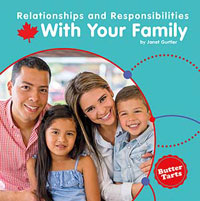 |
With Your Family. (Relationships and Responsibilities).
Janet Gurtler.
Collingwood, ON: Butter Tarts/Beech Street Books, 2018.
24 pp., pbk., hc., PDF & HTML, $9.95 (PBK. LST), $7.96 (PBK. DISC), $24.25 (HC. LST), $19.40 (HC. DISC).
ISBN 978-1-77308-196-0 (pbk.), ISBN 978-1-77308-136-6 (hc.), ISBN 978-1-77308-256-1 (PDF), ISBN 978-1-77308-295-0 (HTML).
Subject Heading:
Families-Juvenile literature.
Grades 1-2 / Ages 6-7.
Review by Dave Jenkinson.
** /4
|
| |
|
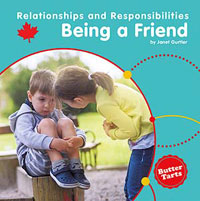 |
Being a Friend. (Relationships and Responsibilities).
Janet Gurtler.
Collingwood, ON: Butter Tarts/Beech Street Books, 2018.
24 pp., pbk., hc., PDF & HTML, $9.95 (PBK. LST), $7.96 (PBK. DISC), $24.25 (HC. LST), $19.40 (HC. DISC).
ISBN 978-1-77308-191-5 (pbk.), ISBN 978-1-77308-131-1 (hc.), ISBN 978-1-77308-251-6 (PDF), ISBN 978-1-77308-290-5 (HTML).
Subject Heading:
Friendship-Juvenile literature.
Grades 1-2 / Ages 6-7.
Review by Dave Jenkinson.
** /4
|
| |
|
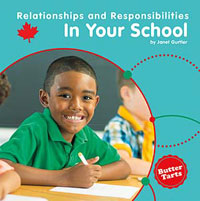 |
In Your School. (Relationships and Responsibilities).
Janet Gurtler.
Collingwood, ON: Butter Tarts/Beech Street Books, 2018.
24 pp., pbk., hc., PDF & HTML, $9.95 (PBK. LST), $7.96 (PBK. DISC), $24.25 (HC. LST), $19.40 (HC. DISC).
ISBN 978-1-77308-195-3 (pbk.), ISBN 978-1-77308-135-9 (hc.), ISBN 978-1-77308-255-4 (PDF), ISBN 978-1-77308-294-3 (HTML).
Subject Headings:
Schools-Juvenile literature.
School environment-Juvenile literature.
Grades 1-2 / Ages 6-7.
Review by Dave Jenkinson.
** /4
|
| |
|
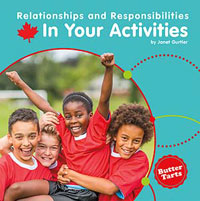 |
In Your Activities. (Relationships and Responsibilities).
Janet Gurtler.
Collingwood, ON: Butter Tarts/Beech Street Books, 2018.
24 pp., pbk., hc., PDF & HTML, $9.95 (PBK. LST), $7.96 (PBK. DISC), $24.25 (HC. LST), $19.40 (HC. DISC).
ISBN 978-1-77308-192-2 (pbk.), ISBN 978-1-77308-132-8 (hc.), ISBN 978-1-77308-252-3 (PDF), ISBN 978-1-77308-291-2 (HTML).
Subject Headings:
Exercise-Juvenile literature.
Physical fitness for children-Juvenile literature.
Sports for children-Juvenile literature.
Sports for children-Juvenile literature.
Sportsmanship-Juvenile literature.
Exercise-Physiological aspects-Juvenile literature.
Grades 1-2 / Ages 6-7.
Review by Dave Jenkinson.
** /4
|
| |
|
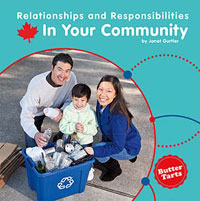 |
In Your Community. (Relationships and Responsibilities).
Janet Gurtler.
Collingwood, ON: Butter Tarts/Beech Street Books, 2018.
24 pp., pbk., hc., PDF & HTML, $9.95 (PBK. LST), $7.96 (PBK. DISC), $24.25 (HC. LST), $19.40 (HC. DISC).
ISBN 978-1-77308-193-9 (pbk.), ISBN 978-1-77308-133-5 (hc.), ISBN 978-1-77308-253-0 (PDF), ISBN 978-1-77308-292-9 (HTML).
Subject Headings:
Communities-Juvenile literature.
Community life-Juvenile literature.
Social participation-Juvenile literature.
Grades 1-2 / Ages 6-7.
Review by Dave Jenkinson.
** /4
|
| |
|
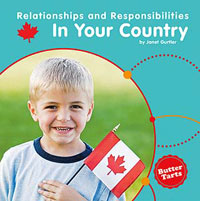 |
In Your Country. (Relationships and Responsibilities).
Janet Gurtler.
Collingwood, ON: Butter Tarts/Beech Street Books, 2018.
24 pp., pbk., hc., PDF & HTML, $9.95 (PBK. LST), $7.96 (PBK. DISC), $24.25 (HC. LST), $19.40 (HC. DISC).
ISBN 978-1-77308-194-6 (pbk.), ISBN 978-1-77308-134-2 (hc.), ISBN 978-1-77308-254-7 (PDF), ISBN 978-1-77308-293-6 (HTML).
Subject Headings:
Citizenship-Canada-Juvenile literature.
Civics, Canadian-Juvenile literature.
Grades 1-2 / Ages 6-7.
Review by Dave Jenkinson.
** /4
|
| |
|

excerpt:
Parents can be two dads, two moms, a single parent, or a dad and mom. Some children are adopted. The parents who adopt them are their parents. These children might have relationships with their biological parents, too. There are many ways to be a family. (From With Your Family.)
Sometimes friends will laugh with you. They also share sad feelings. Friends can help you understand other people. Our friends teach us that people have differences. We don’t always like the same things. You will find similarities and differences. (From Being a Friend.)
Some kids love group sports, such as soccer, hockey, baseball or basketball. There are many great things about being on a sports team. Team teach kids how to work together. Competition teaches children how to win and lose while still being kind. These are important lessons in life. (From In Your Activities.)
Students at school can learn how to make goals. Teachers and parents or guardians can help students figure out what goals to set for themselves. They can also help with ways to reach these goals. (From In Your School.)
Community members help communities stay safe. Homeowners in a neighbourhood shovel their sidewalks in the winter. That way, walking is safe for everyone. Families and schools teach children rules to keep them safe. One rule is that children should always wear helmets when riding their bikes. (From In Your Community.)
When someone loves their country deeply, they have a lot of pride in it. People show their pride in different ways. One way is to cheer on sports teams. Athletes represent Canada in many different sports. It’s fun to root for Team Canada to win. (From In Your Country.)
The Saunders Book Company catalogue describes the six volume “Relationships and Responsibilities” series as follows: “All Canadians have relationships and responsibilities that impact their lives. Whether at school, at home, or in the community, these roles engage Canadians with the world around them. Relationships and Responsibilities offers readers a closer look at how these roles are connected to one’s identity, culture and sense of worth.”
The series exhibits a logical overall structure by starting where relationships and responsibilities begin - in the home. Each of the following volumes expands the radius of these relationships and responsibilities outward (with some overlap), to friends, to school, to activities beyond the school, to the wider community, and ultimately to the nation. What is unclear is whether or not author Gurtler meant the books to be read in a specific order or if they were to stand as separate entities.
Each book in the series contains four brief chapters that total 21 large print pages, but, from five to eight pages are occupied by full-colour photographs. As well, additional smaller photos consume more space. On the positive side, those children and adults shown in the largely decorative photos do reflect Canada’s racial diversity (and With Your Family portrays same sex parents). Nonetheless, when the visual aspects of the books are subtracted, text-wise, the books are brief. Two of the final three pages contain a glossary and suggested print and Web resources for further reading. The final page is shared between an index and a number of “Quick Questions” for the reader’s consideration.
The glossaries provide definitions of 8-11 terms that appeared in red in the text. Why these particular terms were selected is unclear as some of the words, such as “common”, “fair”, “active”, “explore”, “safe” and “favourite”, I would expect to be in the daily vocabularies of most of the series’ intended audience. While I could argue that the books’ texts contains other words that also merited definition, to do so would only obscure the fact that books aimed at beginning readers (the publisher’s catalogue identifies “Reading Level: Grades 1-2") shouldn’t require glossaries. Beginning readers who are attempting to develop fluidity in independent reading do not need to have the text interrupted by the need to turn to a glossary in order to find out what a word means. For this audience, words should be defined in context. One of the worst examples of not defining a word in context occurs in “Chapter 3 Setting Goals” of In Your School wherein the first sentence reads: “Students at school can learn how to make goals.” Given the chapter’s title focus, rather than making the reader turn from p. 14 to p. 22, would it not have made more sense to use the opening sentence to define (and possibly illustrate) what a goal is?
Given that five of the six books included the word “Your” in their titles, it is odd that Gurtler elected to write in the third person, thereby distancing her readers from what she had to say. In an attempt to lighten up what is, overall, a rather uninteresting text, Gurtler includes circled “Fun Facts”, one such being, “Kids use many pencils in school. Most pencils write 45,000 words or draw a line over 56 km. long.” That example is one of the few “fun Facts” that is truly fun and something a child would want to share with another. Unfortunately, most of the “Fun Facts” are just boring, such as this “Fun Fact”: “Kids can help their community stay clean, They can recycle empty bottles and pick up garbage in their community.”
Because it’s unlikely that most students would elect to read the books in this series as “free-choice” reading, teachers will be the intermediaries who will incorporate the books’ contents into curricular units about the family and the larger communities of which their students are a part. To that end, the penultimate page, labelled “To Learn More”, which contains three books and an equal number of websites, might prove to be useful. With the exception of In Your Country, where two of the three books listed were identified by the publisher as having a grade 5/6 reading level, by and large the books indicated in the other five books in the series were at an appropriate 1-2 reading level. Teachers may find that they need to intervene in students’ searches of the suggested websites in order to direct them to the appropriate sections.
The books’ final page has an unnecessary index for such short books (I know -we’re trying to teach students the parts of a book, but....) and at least three bulleted open-ended questions that relate to a specific book’s contents. For example, the questions in In Your School ask:
- How can treating someone else with respect make you feel better about yourself?
- What is something students do that could be recognized with a character award?
- What is a specific goal you could make for your school work? How will you achieve this goal?
The six books’ questions are worth asking even if students do not read any of the books.
As noted earlier, this series probably requires a teacher catalyst, and so, in an ideal world, before teachers make purchase decisions, they should personally examine the entire series to see how individual titles would fit into their teaching needs.
Recommended with Reservations.
Dave Jenkinson, CM’s editor, lives in Winnipeg, MB.

© CM Association
CC BY-NC-ND
Hosted by:
University of Manitoba
ISSN 1201-9364
|
This Creative Commons license allows you to download the review and share it with others as long as you credit the CM Association. You cannot change the review in any way or use it commercially.
Commercial use is available through a contract with the CM Association. This Creative Commons license allows publishers whose works are being reviewed to download and share said CM reviews provided you credit the CM Association. |
Next Review | Table of Contents for This Issue - April 13, 2018.
CM Home | Back Issues | Search | CM Archive | Profiles Archive
|





